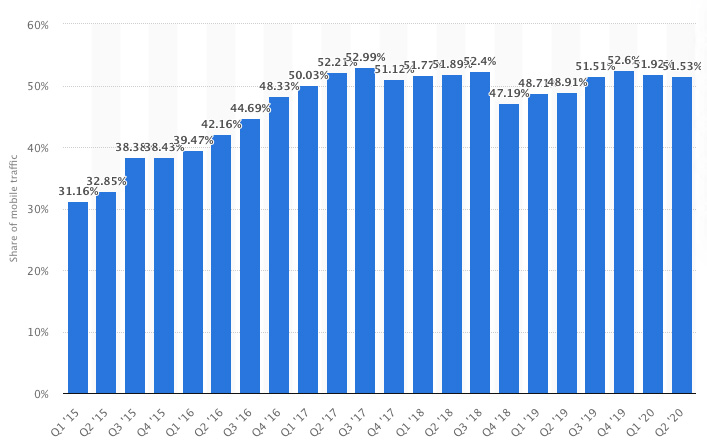In a world working and shopping remotely, SEO strategy is more critical than ever before. Ranking well on the search engines keeps business relevant and productive during the more challenging times. SEO testing is the only way to determine what works, what doesn’t, and how to improve optimization in the future.
SEO testing helps companies do a better job of satisfying their customers’ needs.
The only constant in SEO is changing as Google continually strives to improve the user experience. Ultimately, SEO testing is an excellent way for management to refine their offerings to appeal to its target audience.
As a result, SEO testing is based on a series of changes, testing, and learning what works based on researched results. Speculation is sure to send companies down the wrong path. Find out more about using facts and figures to create campaigns that resonate with your audience and get them to take action.
What is the Purpose of SEO Testing?
SEO testing evaluates the best strategies to optimize your pages for SERPs. By studying data and experimenting with updates, strategists find the best ways to improve marketing campaigns and achieve measurable results. The data reveals facts and figures about content, rather than opinions.
Changes made on-page are analyzed to determine if they work or other improvements should be made. To further refine campaign efforts, split testing divides traffic to different versions of the page to see what updates work best based on conversion rates. For example, a highly trafficked page that doesn’t convert needs improvement. Conversely, a low-trafficked page with excellent conversion rates could be tweaked to expand its reach.
Ultimately, SEO testing ensures a good ROI for marketing efforts. By figuring out what works and what doesn’t, changes can be implemented to improve rankings and conversions. Ongoing testing is crucial to remain relevant in a rapidly changing online climate. Without SEO testing, marketers and management are taking a shot in the dark. Testing takes the guesswork out of the process, providing valid proof of necessary updates.
Google Analytics is the Source for SEO Testing
Veteran SEO strategies remember when Yahoo was the leading search engine. Today Google is the source when it comes to search engine optimization. Google Analytics measures SEO metrics to develop marketing campaigns based on facts rather than speculative trial-and-error. Record results on a spreadsheet to keep track of campaign progress. Using spreadsheets is a time-consuming process, so many tools exist to help facilitate SEO testing, such as Moz and Brightedge.
Whether marketers hash out findings in Google Analytics or use a time-saving tool to get results, there are a few basic metrics to track for optimum results.
- Bounce rate is the number of people who left the website after viewing just one page.
- Dwell time is the length of time a visitor spends on a page.
- Time on the page shows how long visitors are engaged with a page, which should be at least two minutes or longer.
- Site speed is crucial to ensure visitors instantly access what they need at the site rather than surfing away to the faster competition – pages, images, and video should load quickly or be compressed.
- With more than half of web traffic coming from mobile devices, ensuring a site is mobile-friendly and reaches out to mobile users is crucial to be relevant in the future.

- Determine the return on investment for SEO campaigns to figure out what works and where change is required
- Analyze the organic conversion rate, as traffic without conversion is meaningless.
Most professional marketers use Google Analytics with SEO tools to generate comprehensive reports. Management reviews the reports with their marketing team to make necessary tweaks to content, social media posts, and the site’s backend to improve optimization.
Make Traffic Matter
Relevant content that answers the target audience’s questions brings in more traffic. Once the traffic arrives, the goal is to keep them there until they take action. If they surf away, the site content should give them a reason to return – giving the company another opportunity to convert a visitor into a customer.
Refreshing content is an effective way to ensure it reaches out to visitors. SEO testing reveals keywords and content that attracts traffic, content that performs well, where the traffic comes from, and other potential keywords to drive more visitors to the site. Updating existing content with new facts, links and keywords helps improve its performance and maximizes your original SEO investment. Look for low-hanging fruit – keywords with high traffic and low competition – to boost ranking and define a company’s niche market.
Plus, ongoing analysis helps the marketing team develop new content topics based on current trends. Companies on the cutting edge of recent market developments become valued resources, increasing brand awareness, and establishing authority. When customers rely on a company’s information, they tend to trust it and be willing to take action.
Tag – You’re It
Well-researched content with relevant keywords is just the beginning. Content, including video and images, must be tagged for search engines to find it. Updated keyword research also means refreshing the tags associated with the content. Ignoring the backend means losing ranking and traffic.
Review title tags and topic tags to ensure they remain relevant based on current analytics. Find older content that might be missing tags and make necessary updates so that searchers can found it. Include tags for images and videos on blogs and social media. Optimized interactions are another essential aspect of SEO.
Also, consider canonical tags, the URLs that represent master copies of a page. Using a canonical tag can prevent issues associated with duplicate or similar content appearing on multiple URLs. As a site grows, canonical tags avoid confusion and problems related to identical content that can reduce ranking and credibility.

Work on Your Images
Unique content improves branding and brings visitors back to a website. Making content unforgettable means answering questions, providing useful information, and pairing relevant images. People who hear information only retain 10 percent of it days later, while adding a photo to this information helps them retain 65 percent of it up to three days later. The right images keep your content on visitors’ minds.
Outdated images from a decade ago should be updated with new tags. Test images and pages for speed, then compress, delete, and add for faster uploading. Slow speeds send visitors away, and ideally, images should load within 2 seconds, or the bounce rate for the page notably increases.
Tag all images with related keywords, based on traffic and competition. Consider adding original and professional pictures to some content, rather than stock photos. When using stock images, choose unique images that aren’t found frequently around the web.
Find the Missing Link
Linking is another aspect to track during SEO testing. Internal and external linking can help improve content usefulness and ranking when done the right way. Broken links and 404-page errors bring site ranking down. Keeping track of site links enhances the user experience and keeps visitors on-page longer – the goal is for them to stay for several minutes.
Reciprocal links are another way to engage consumers, attract more traffic, and improve overall rank. Working with related businesses and sharing content for the benefit of the target audience, rather than marketing, creates beneficial relationships for everyone. When links are based on relationships rather than payment, they tend to be evergreen.
Guest posting and top-notch directories, such as Google and Yelp, are other places to build links. Guest articles should appear at reputable, well-established websites with a dedicated following to provide real value to readers and SEO. Continued SEO testing shows link building results, helping to direct this fundamental aspect of optimization.
Refresh, Renew, Revitalize
When it comes to SEO, what worked yesterday will not work today or tomorrow. With more than 200 existing algorithms to consider, the possibilities are dizzying for the most seasoned marketers and managers. SEO testing is the only way to hone in on current content performance and create new content that matters.
SEO testing yields reports that matter to everyone from the C-suite to the content development and social media marketing teams. Finding a niche, honing your focus, and updating your approach according to current algorithms means staying ahead of the curve. Defining a niche market often gives companies an edge over the competition. Calls to action should be recent, with offers to entice visitors to stay connected. Comparing content approaches for several weeks with SEO tracking and testing helps refine where articles need tweaking, such as a more compelling call to action.
Content refreshes keep a site relevant in the current market. Outdated statistics and quotes make newer content outrank potentially evergreen articles that could provide real value to visitors. Researched tags, links to new resources, relevant metadata, and updated facts make the content fresh.
Web Design
SEO testing also helps detect where website design issues exist, such as page loading speed and button location. Calls to action should be clear, with buttons for easy access to the next page for interaction. Factors such as colors, fonts, content length, and more impact site ranking and overall user experience.
Other elements should also be present and updated, such as the sitemap and indexing. Most sites are secure today, with a URL that begins with HTTPS. Anything less is a security issue that also makes a site lack authority and trust and potentially loses ranking to the competition.
Content should be visible on any device because many consumers access sites via mobile devices, A strong mobile strategy is vital for local businesses looking to reach out to people searching for companies in the neighborhood. SEO testing indicates areas that require improvement, which could include updating web design elements.
Measuring PPC
Organic traffic is a rich resource with unlimited possibilities for a minimal investment in SEO. A mix of evergreen and new content can put a site on Google’s first page and keep it there. Paid advertising is another crucial strategy that should be measured by SEO testing to determine its progress.
Paid campaigns require ongoing monitoring to ensure an ROI. Cross-campaigning to attract targeted paid and organic traffic is an effective mix. SEO testing helps companies determine a budget for each based on facts.
Many companies outsource SEO testing because it is a detailed process requiring continued monitoring. Changes must be carefully made and considered for a few weeks to determine what works best. Most in-house marketing teams are too busy to continually contemplate analytics. Plus, ongoing algorithm updates dictate what changes are necessary best on current practices.
Working with a strategic partner, such as the pros Galileo Tech Media, keeps your marketing team on-top of their game. SEO testing and reports show the value of working with an expert team who understands how to interpret, communicate, and process reporting results.
Contact us today to learn more about SEO testing and why it is crucial for businesses today. Discover the benefits of reviewing SEO results with the C-suite for branding, authority, and a more profitable online presence.

